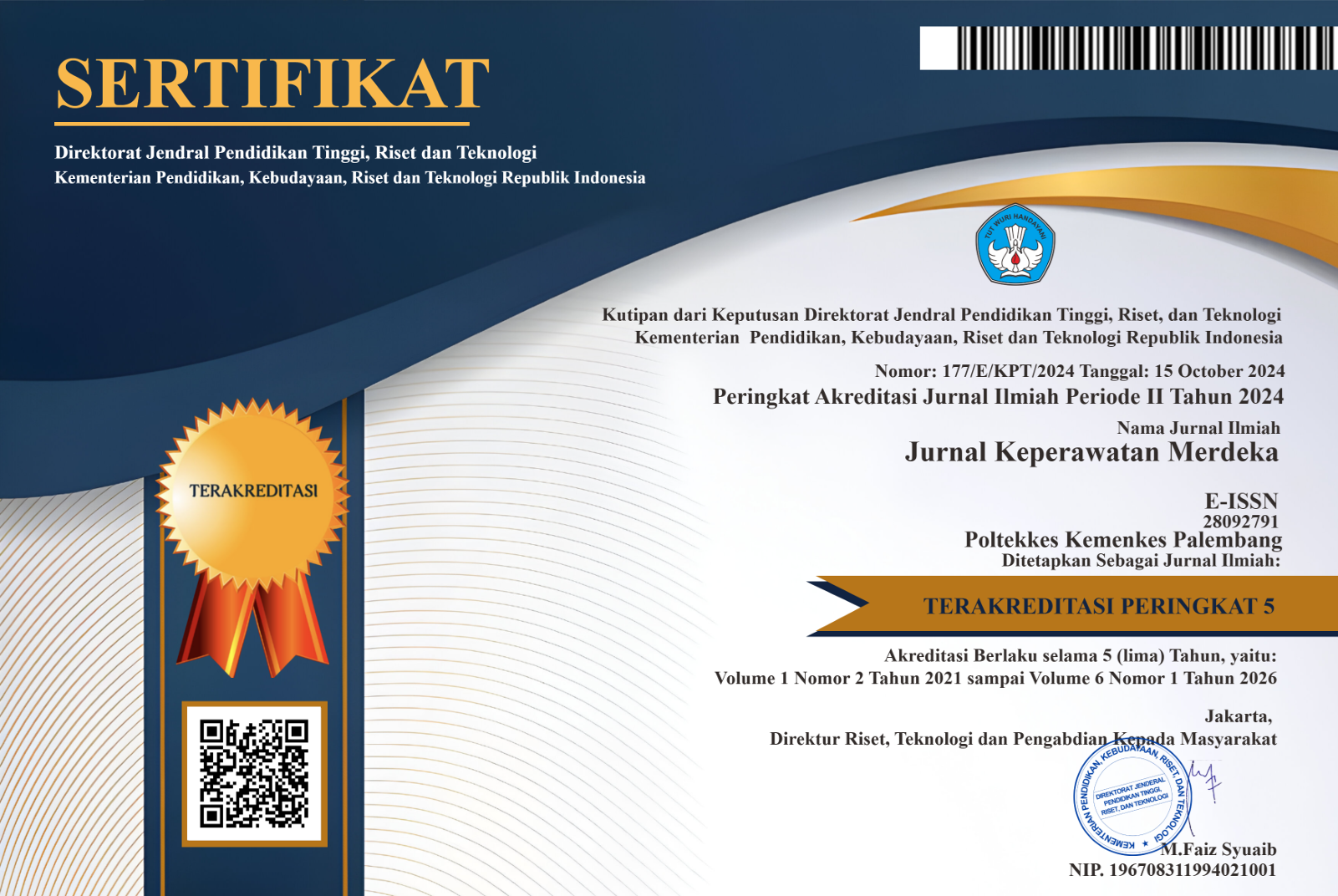Hubungan Penggunaan Media Elektronik dengan Keluhan di Mata Remaja dengan Pembelajaran Online Masa Pandemi Covid-19
Abstract
Latar Belakang: Pemerintah menurunkan kebijakan dibidang pendidikan pada masa pandemi salah satunya yaitu Proses Belajar Mengajar (PBM) melalui online. Sistem pembelajaran online menggunakan jaringan internet memberikan risiko kepada kesehatan mata siswa. Penelitian ini bertujuan untuk mengetahui hubungan penggunaan media elektronik dengan keluhan mata pada remaja dengan pembelajaran online dimasa pandemi. Metode: Desain Penelitian ini menggunakan deskriptif kuantitatif dengan pendekatan cross sectional. Teknik pengambilan sampel dengan total sampel. Jumlah sampel diperoleh 587 responden. Pengambilan data menggunakan google form. Analisis bivariat menggunakan chi-square. Hasil: Karakteristik responden sebagian besar 457 responden (77,85%) sebagai pelajar SMA. Responden jenis kelamin laki-laki dan perempuan hampir sama yaitu 310 responden (52,8%) dan 277 responden (47,2%). Hasil uji bivariat adalah terdapat hubungan antara penggunaan media elektronik dengan keluhan mata remaja pembelajaran online. Kesimpulan: Penggunaan media elektronik berdampak pada kesehatan mata remaja. Pemberian informasi kepada orang tua untuk mengatur jadwal dan durasi penggunaan media kepada siswa.
References
Abusamak, M., Jaber, H., & Alrawasdeh, H. M. (2021). The Effect of Lockdown Due to the COVID-19 Pandemic on Digital Eye Strain Symptoms Among the General Population - A Cross-Sectional Study (pp. 1–20). https://doi.org/10.21203/rs.3.rs-500071/v1
Alghamdi, W. M., & Alrasheed, S. H. (2020). Impact of an educational intervention using the 20/20/20 rule on Computer Vision Syndrome. African Vision and Eye Health, 79(1), 1–6. https://doi.org/10.4102/AVEH.V79I1.554
Asnel, R., & Kurniawan, C. (2020). Analisis Faktor Kelelahan Mata pada Pkerja Pengguna Komputer. Jurnal Endurance, 5(2), 356–365.
Bahkir, F. A., & Grandee, S. S. (2017). Impact of the COVID-19 Lockdown on Digital Device-Related Ocular Health Fayiqa. BMC Ophthalmology, 17(1), 1. https://doi.org/10.4103/ijo.IJO
BMKG. (2021). Indeks Sinar Ultraviolet (UV). Badan Meteorologi, Klimatologi, Dan Geofisika. https://www.bmkg.go.id/cuaca/indeks-uv.bmkg
Carlson, S. A., Fulton, J. E., Lee, S. M., Foley, J. T., Heitzler, C., & Huhman, M. (2010). Influence of limit-setting and participation in physical activity on youth screen time. Pediatrics, 126(1). https://doi.org/10.1542/peds.2009-3374
Darmawan, D., & Wahyuningsih, A. S. (2021). Keluhan Subjektif Computer Vision Syndrome Pada Pegawai Pengguna Komputer Dinas Komunikasi dan Informasi. Indonesian Journal of Public Health and Nutrition, 1(2), 172–183. http://journal.unnes.ac.id/sju/index.php/IJPHN
Falahudin, I. (2017). Pemanfaatan Media dalam Pembelajaran. Jurnal Lingkar Widyaiswara, 6(2), 402–416.
Gayatri, I. G. A. I. A., Puspita, L. M., & Suarningsih, N. K. A. (2021). Hubungan Intensitas Penggunaan Gadget Dengan Keluhan Computer Vision Syndrome Pada Siswa-Siswi Di Smpn 4 Denpasar. Coping: Community of Publishing in Nursing, 8(4), 446. https://doi.org/10.24843/coping.2020.v08.i04.p14
Insani, Y., & Wunaini, N. (2018). Hubungan Jarak Mata dan Intensitas Pencahayaan terhadap. Manajemen Kesehatan Yayasan RS. Dr.Soetomo, 4(2), 153–162.
Istiqomah, S. N., & Lisiswanti, R. (2017). Dampak Eksposur Layar Monitor Terhadap Gangguan Tidur Dan Tingkat Obesitas Pada Anak. Majority, 6(2), 72–77. http://juke.kedokteran.unila.ac.id/index.php/majority/article/download/1016/1738
Kaya, H. (2020). Investigation of The Effect of Online Education on Eye Health in Covid-19 Pandemic. International Journal of Assessment Tools in Education, 7(3), 488–496. https://doi.org/10.21449/ijate.788078
Kumala, A. M., Margawati, A., & Rahadiyanti, A. (2019). Hubungan Antara Durasi Penggunaan Alat Elektronik (Gadget), Aktivitas Fisik Dan Pola Makan Dengan Status Gizi Pada Remaja Usia 13-15 Tahun. Journal of Nutrition College, 8(2), 73. https://doi.org/10.14710/jnc.v8i2.23816
Latupono, S., Tualeka, S., & Taihuttu, Y. (2021). Hubungan Penggunaan Media Elektronik dengan Sindrom Mata Kering di Fakultas Kedokteran Universitas Pattimura. Molucca Medica, 14(1), 22–35.
Lee, J. W., Cho, H. G., Moon, B. Y., Kim, S. Y., & Yu, D. S. (2019). Effects of prolonged continuous computer gaming on physical and ocular symptoms and binocular vision functions in young healthy individuals. PeerJ, 2019(6), 1–14. https://doi.org/10.7717/peerj.7050
Mersha, G. A., Hussen, M. S., Belete, G. T., & Tegene, M. T. (2020). Knowledge about Computer Vision Syndrome among Bank Workers in Gondar City, Northwest Ethiopia. Occupational Therapy International, 2020. https://doi.org/10.1155/2020/2561703
Mohan, A., Sen, P., Shah, C., Jain, E., & Jain, S. (2017). Prevalence and Risk Factor Assessment of Digital Eye Strain Among Children Using Online E-learning During the COVID-19 Pandemic: Digital Eye Strain Among Kids (DESK study-1). BMC Ophthalmology, 17(1), 1. https://doi.org/10.4103/ijo.IJO
Murdiningsih, M., Rosnani, R., & Arifin, H. (2016). Corelation Between Pornographic Media and Influence of Peers With Unsafe Sexual Behavior in Adolescent of South Sumatera. Jurnal NERS, 11(2), 210. https://doi.org/10.20473/jn.v11i22016.210-212
Patil, A., Bhavya, Chaudhury, S., & Srivastava2, S. (2019). Eyeing Computer Vision Syndrome: Awareness, Knowledge, and Its Impact on Sleep Quality Among Medical Students. Industrial Psychiatry Journal, 28(1), 68–74. https://doi.org/10.4103/ipj.ipj
Utami, A. R. T., Suwondo, A., & Jayanti, S. (2018). Faktor Risiko Yang Berhubungan Dengan Kelelahan Mata Pada Pekerja Home Industry Batik Tulis Lasem. Jurnal Kesehatan Masyarakat (e-Journal), 6(5), 469–475.
Copyright (c) 2021 JKM : Jurnal Keperawatan Merdeka

This work is licensed under a Creative Commons Attribution-ShareAlike 4.0 International License.
Authors who publish with this journal agree to the following terms:
- Authors retain copyright and grant the journal right of first publication with the work simultaneously licensed under a Creative Commons Attribution License that allows others to share the work with an acknowledgement of the work's authorship and initial publication in this journal.
- Authors are able to enter into separate, additional contractual arrangements for the non-exclusive distribution of the journal's published version of the work (e.g., post it to an institutional repository or publish it in a book), with an acknowledgement of its initial publication in this journal.
- Authors are permitted and encouraged to post their work online (e.g., in institutional repositories or on their website) prior to and during the submission process, as it can lead to productive exchanges, as well as earlier and greater citation of published work













